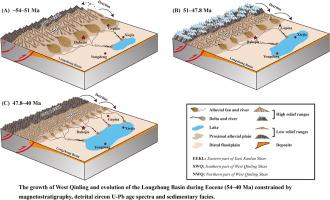Gondwana Research ( IF 7.2 ) Pub Date : 2021-08-08 , DOI: 10.1016/j.gr.2021.07.027 Zhantao Feng 1, 2, 3 , Weilin Zhang 2, 3 , Xiaomin Fang 1, 2, 3 , Jinbo Zan 2, 3 , Tao Zhang 4 , Chunhui Song 4 , Maodu Yan 2, 3

|
The process and mechanism of deformation in the northeastern Tibetan Plateau (NETP) are significant for understanding the remote effects of the India-Eurasia collision. Although increasingly more research has extensively addressed the post-Oligocene NETP growth history over the past two decades, geological dating of early Cenozoic sediments remains sparse, hampering our understanding of early-stage tectonic growth in this region. Here, we present magnetostratigraphic results from the oldest sedimentary record between ~54 and 40 Ma in the western part of the Linxia Basin based on correlation with the geomagnetic polarity time scale. This age exceeds that of the oldest strata previously known (29 Ma) and has great potential for recording paleoclimatic and paleontological evolution in the fossil-rich Linxia Basin. Integrating our paleomagnetic chronology, sedimentary facies, accumulation rate, and provenance results reveals that early-stage Linxia Basin development was associated with Eocene growth of the West Qinling. The U-Pb age distributions of detrital grains from pre-51 Ma strata are characterized by many 200–300 Ma ages; alluvial fans and north-directed paleocurrent data indicate a single and relatively proximal source. The northern segment of the West Qinling was the predominant source supplying sediments to the Linxia Basin before ~51 Ma. Subsequently, a pronounced increase in the sedimentation rate at ~51 Ma and southward migration of the sedimentary system during 51–47.8 Ma demonstrate that extension and fast exhumation of the sediment source occurred. Detrital zircon U-Pb age spectra since ~51 Ma reveal significant increases in Precambrian peaks (1500–2000 Ma and 2300–2600 Ma). These observations suggest accelerated growth of the southern segment of the West Qinling and/or eastern segment of the East Kunlun Shan between 51 and 47.8 Ma. The Eocene basin evolution and accelerated uplift of ranges in the NETP imply near-synchronicity of crustal shortening and deformation across the entire India-Eurasia collision zone.
中文翻译:

青藏高原始新世变形:来自临夏盆地最古老沉积层序的磁地层约束的指示
青藏高原东北部(NETP)的变形过程和机制对于理解印度-欧亚大陆碰撞的远程影响具有重要意义。尽管在过去的二十年中,越来越多的研究广泛解决了渐新世后 NETP 的生长历史,但早期新生代沉积物的地质年代仍然稀少,阻碍了我们对该地区早期构造生长的理解。在这里,我们根据与地磁极性时间尺度的相关性,展示了临夏盆地西部约 54 至 40 Ma 最古老沉积记录的磁地层结果。这个年龄超过了先前已知的最古老地层(29 Ma),具有记录化石丰富的临夏盆地古气候和古生物演化的巨大潜力。综合古地磁年代学、沉积相、成藏速率和物源结果,表明临夏盆地早期发育与西秦岭始新世的生长有关。51 Ma 以前地层碎屑颗粒的 U-Pb 年龄分布具有许多 200-300 Ma 年龄的特征;冲积扇和北向古洋流数据表明一个单一且相对近端的源。在~51 Ma之前,西秦岭北段是临夏盆地沉积物的主要供给源。随后,~51 Ma 的沉积速率显着增加,并且在 51-47.8 Ma 期间沉积系统向南迁移,表明沉积物源发生了扩张和快速剥脱。自~51 Ma 以来的碎屑锆石 U-Pb 年龄谱显示前寒武纪峰(1500-2000 Ma 和 2300-2600 Ma)显着增加。这些观察结果表明西秦岭南段和/或东昆仑山东段在 51 到 47.8 Ma 之间加速生长。始新世盆地演化和 NETP 范围内的加速隆升意味着整个印度-欧亚碰撞带的地壳缩短和变形近乎同步。











































 京公网安备 11010802027423号
京公网安备 11010802027423号